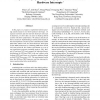Free Online Productivity Tools
i2Speak
i2Symbol
i2OCR
iTex2Img
iWeb2Print
iWeb2Shot
i2Type
iPdf2Split
iPdf2Merge
i2Bopomofo
i2Arabic
i2Style
i2Image
i2PDF
iLatex2Rtf
Sci2ools
82
Voted
RTSS
2007
IEEE
2007
IEEE
Implementing Hybrid Operating Systems with Two-Level Hardware Interrupts
In this paper, we propose to implement hybrid operating systems based on two-level hardware interrupts. To separate real-time and non-real-time hardware interrupts by hardware, we show that it is easier to build up hybrid systems with better performance. We analyze and discuss the key issues for implementing a hybrid system based on this and implement a hybrid system called RTLinux-THIN (Real-Time LINUX with Two-level Hardware INterrupts) on the ARM architecture by combining ARM Linux kernel 2.6.9 and C/OS-II. We conduct experiments on a set of real application programs including mplayer [20], Bonnie [4] and iperf [13] and compare the interrupt latency distributions for RTLinux-THIN (with and without cache locking), RTAI and Linux on a hardware platform based on Intel PXA270 processor [12]. The experimental results show that RTLinux-THIN improves real-time interrupt latencies and provides better predictability.
Applied Computing | Hardware Interrupts | Hybrid System | RTSS 2007 | Two-level Hardware Interrupts |
Related Content
| Added | 04 Jun 2010 |
| Updated | 04 Jun 2010 |
| Type | Conference |
| Year | 2007 |
| Where | RTSS |
| Authors | Miao Liu, Zili Shao, Meng Wang, Hongxing Wei, Tianmiao Wang |
Comments (0)

